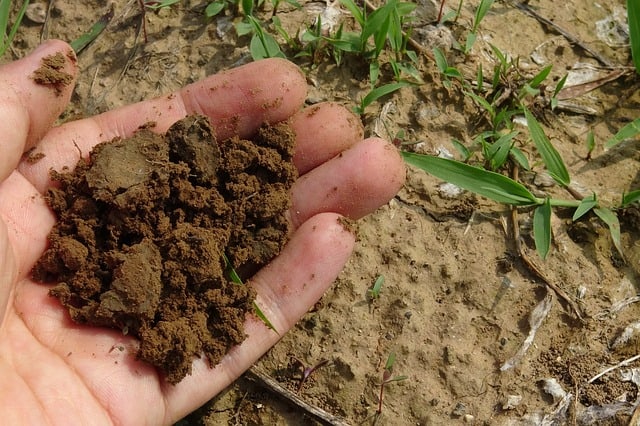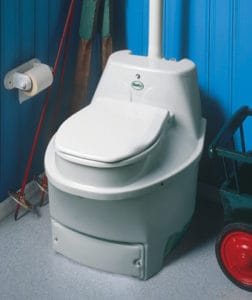Given the right conditions, anything will rot. Composting can be defined as optimizing conditions, so aerobic bacteria and other organisms consume the waste, destroying any harmful bacteria and pathogens in the process. The result is a fertilizer that can be safely handled and spread in your garden.
Like how you can compost household scraps, you can also compost human waste. It may seem scary to put composted fecal matter in your garden. However, the process is fairly straightforward. There are even many newer models of compost toilets that simplify the process.
Turning Human Waste into Compost

Bacteria can be divided into two types: aerobic and anaerobic. Aerobic bacteria require oxygen levels of at least 5% survive. By contrast, anaerobic bacteria thrive in conditions with little or no oxygen.
Aerobic bacteria are what you want for composting. They are very efficient in turning waste into compost. They eat up the waste and excrete nutrients that are great for your garden, such as nitrogen, phosphorus, and magnesium.
As aerobic bacteria compost waste, they produce heat. As the temperature increases, different types of aerobic bacteria will take over.
You may have read about these when setting up your compost pile – like mesophilic and thermophilic bacteria. The temperature gets hot enough in a compost pile to sterilize human waste. There’s an excellent overview of these bacteria here.
If anaerobic bacteria are allowed to thrive, things get nasty. They release ammonia-like substances, which cause bad smells and gases.
For aerobic bacteria to thrive, composting toilets must:
- Keep waste oxygenated: Typically, the waste chamber will be rotated so oxygen can reach all waste. An exhaust fan will also assist in blowing air on the waste.
- Maintain carbon-nitrogen balance: Urine contains huge amounts of nitrogen. If urine is allowed in the compost chamber, anaerobic bacteria will get out of control. Thus, almost all compost toilets will have urine-diversion devices. As for the carbon, a bit of peat moss, coconut fiber, or sawdust is added to the chamber.
- Reduce moisture content: Fecal matter is about 75% to 90% liquid by volume. Aerobic bacteria do not thrive in high-moisture environments. However, they do need some moisture to survive. So, compost toilets will have a fan which helps most (but not all) moisture evaporate from the solid waste.
- Regulate temperature: For aerobic bacteria to thrive, temperatures must be kept at around 60 to 100 degrees Fahrenheit. Compost toilets will not work in very cold or freezing weather. Some advanced models of compost toilets have temperature-regulating devices.
Compost Toilets vs. Pit Latrines

All pit latrines are essentially compost toilets: give it enough time, and the waste will eventually be turned into a safe substance.
However, it will take a VERY long time for latrine waste to be turned into compost. It takes so long that the sludge in pit latrines can contaminate groundwater and become a public health risk. This is why pit latrines must be emptied when full and not just covered.
Using a Composting Toilet
Urine should never go in a compost toilet. Urine contains too much nitrogen, and this will cause anaerobic bacteria to take over instead of the aerobic ones we want for composting. Urine will also increase the moisture levels of the compost too much for the aerobic bacteria to thrive.
Each time you go #2 in a compost toilet, you will need to add a handful of carbon material (such as peat moss or dry straw) to the chamber. Then you use the agitator handle to rotate the chamber. You can use a spray bottle with vinegar to clean the bowl of any remaining waste.
The urine collection bottle should be emptied every day. Otherwise, the urine can start to smell bad. The composting chamber should be emptied when nearly full.
The contents of the compost toilet won’t be fully composted yet and thus are not safe to dump in your yard. You will have to place them in a compost bin to complete composting.
Alternatively, you can keep the waste in the chamber to cure. Many people will let the chamber cure for about a year until putting it on their compost heap. You will need multiple replacement chambers while the full chamber completes composting.
DIY Composting Toilets vs. Purchased Composting Toilets

It is straightforward to make a DIY composting toilet. You need a bucket and a urine diverter (or a separate bucket for urinating). Each time you go #2 in the bucket, you put a bit of carbon material over the waste. When it is full, you put it on your compost heap for curing.
The problem with these simple DIY composting toilets is that they don’t always create ideal conditions for composting.
For example, composting slows down drastically at temperatures less than 50F. There’s not much you can do about this if your bathroom is in a bucket. But some advanced portable composting toilets even have temperature sensors and regulators. They keep the temperature set so composting occurs faster.
There are also many other features to love about commercial composting toilets, like:
- Handles for rotating the waste chamber, so it stays oxygenated
- Vents and fans for aerating waste and removing odors
- Flush levers which open/close the chamber so smells can’t escape when it’s not in use
- Designed to resemble regular toilets
- Drains and evaporating chambers which keep moisture levels low
- Closed chambers trap the heat produced naturally by composting microbes
- Multi-chamber systems so composting can be completed in a finishing chamber
These features make using a compost toilet nearly foolproof. The only issue is that they can be costly (in the thousands of dollars). Still, it’s a worthy investment if you plan on going off-grid or prepping for disasters. You can check out our reviews of the best composting toilets here.
If you are interested in learning the science behind composting toilets, I recommend getting The Humanure Handbook: A Guide to Composting Human Manure. It’s a great, informative read and will give you the confidence to start using your own composting toilet.

